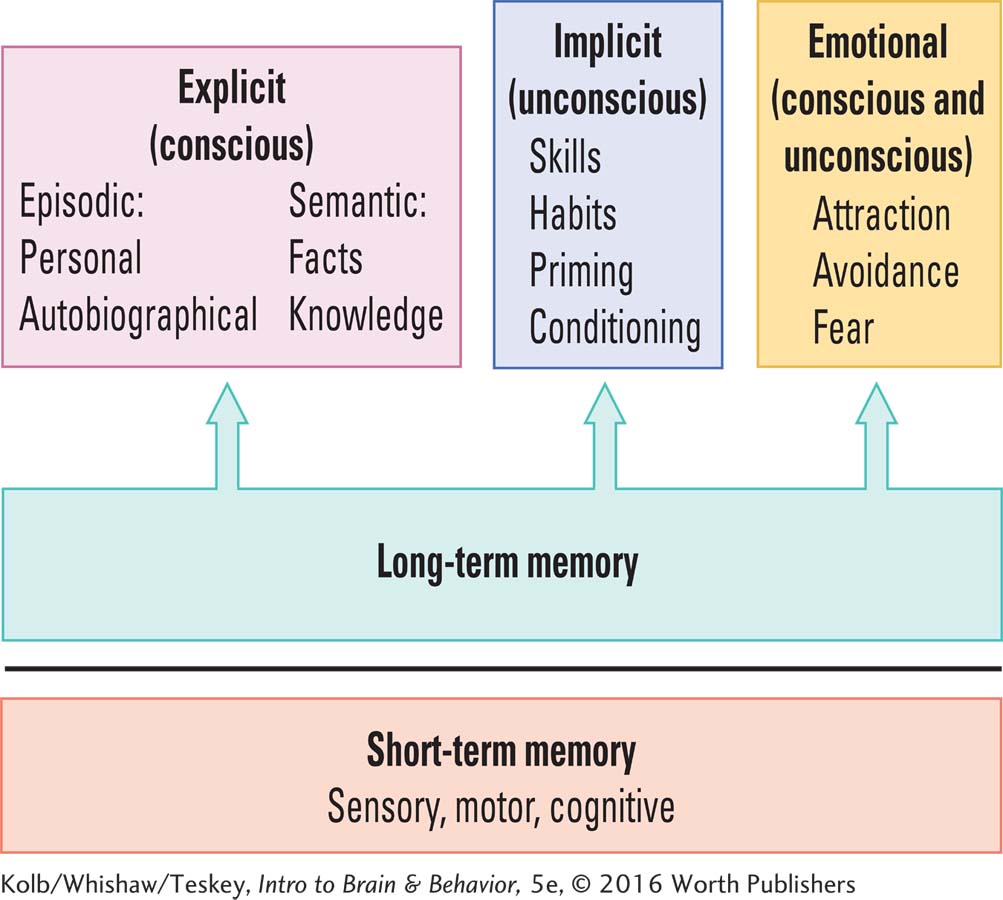SUMMARY
14-1Connecting Learning and Memory
Learning is a change in an organism’s behavior as a result of experience. Memory is the ability to recall or recognize previous experience. For more than a century, laboratory studies using animals have uncovered two diverse types of learning: Pavlovian (or classical) and operant (or instrumental).
The two basic types of memory are implicit (unconscious) and explicit (conscious). Episodic memory includes not only a record of events (episodes) that occurred but also our presence there and our role in the events. The frontal lobe likely plays a unique role in this autobiographical memory.
14-2Dissociating Memory Circuits
Multiple subsystems control different aspects of memory within the explicit and implicit systems. People with damaged explicit memory circuits have impaired recall for facts and events. People with damaged implicit memory circuits are impaired in their recall and/or performance of skills and habits.
14-3Neural Systems Underlying Explicit and Implicit Memories
The neural circuits underlying implicit and explicit memory are distinctly different: the reciprocal system for explicit memory includes medial temporal structures; the unidirectional system for implicit memory includes the basal ganglia. Emotional memory has characteristics of both implicit and explicit memory. Neural circuits for emotional memory also are unique in that they include the amygdala. The chart summarizes broad categories within these multiple memory systems.
For memories to become established in the brain—

14-4Structural Basis of Brain Plasticity
The brain has the capacity for structural change, and structural change presumably underlies functional change. The brain changes structure in two fundamental ways in response to experience.
| Some Guiding Principles of Brain Plasticity |
|---|
| 1. Behavioral change reflects brain change. |
| 2. All nervous systems are plastic in the same general way. |
| 3. Plastic changes are age- |
| 4. Prenatal events can influence brain plasticity throughout life. |
| 5. Plastic changes are brain region dependent. |
| 6. Experience- |
| 7. Plasticity has pros and cons. |
First, existing neural circuits change largely by modifying synaptic connections. One proposed mechanism of synaptic change is long-
Second, novel neural circuits form both by forging new connections among existing neurons and by generating new neurons. Generating new neurons in the hippocampus is one mechanism for establishing novel circuits. A likely mechanism for maintaining synaptic changes is epigenetic: specific sites in the neuronal DNA in modified circuits can exist in either methylated or unmethylated states.
Neuronal activity is key to brain plasticity: through it, synapses form and change. Neuronal activity can be induced by general or specific experience as well as by electrical or chemical stimulation. Chemical stimulation may range from hormones and neurotrophic compounds to psychoactive drugs.
Much of the brain is capable of plastic change with experience. Different experiences lead to changes in different neural systems. The table summarizes seven principles that guide research about brain plasticity and behavior.
14-5Recovery from Brain Injury
Plastic changes after brain injury parallel those seen when the brain changes with experience. Changes related to recovery do not always occur spontaneously, however, but must be stimulated by behavioral training, by the effects of psychoactive drugs or neurotrophic factors, or by electrical brain stimulation. The key to stimulating recovery from brain injury is to increase the plastic changes underlying the recovery.